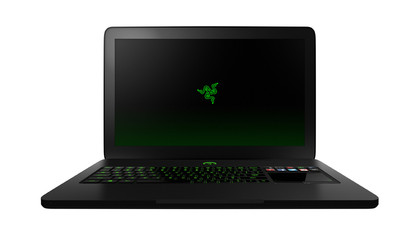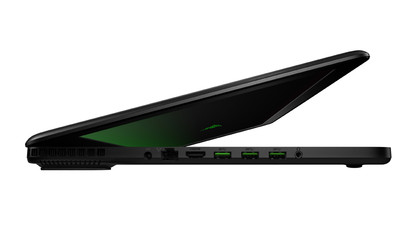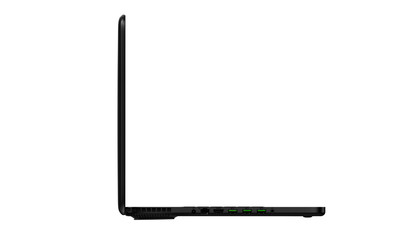TechRadar Verdict
From top to bottom, the Razer Blade is a very well-thought out design, and is a joy to use on a day to day basis. It's hard to imagine porting around a 17-inch laptop, but at only a little under 7 pounds all-in and with surprisingly stellar battery life, the previously unthinkable is perfectly reasonable here.
Pros
- +
Extremely fast
- +
Thin and light
- +
Snappy aesthetics
- +
Great battery life
- +
Above average audio
Cons
- -
Super expensive
- -
Stiff keyboard
- -
Flimsy mouse buttons
- -
No Blu-Ray player
Why you can trust TechRadar
First reviewed September 30 2012
Update: In light of the new 14-inch Razer Blade, the 17-inch version of the Razer Blade, reviewed here, is now known as the Razer Blade Pro.
In both form and function, there's a lot to love about Razer's new 17-inch Razer Blade Pro gaming laptop. It's attractive, thin, lightweight, and very, very fast.
Far and away, however, the feature everyone notices first - and that you'll want to show off to your friends, family, and fellow/random tech nerds - is first-of-its-kind Switchblade touchpad interface. This unique new feature turns the Blade's touchpad into a fully functioning second screen that allows you to check your email, watch YouTube videos, or - best of all - amplify your gaming experience.
This final point is the most important of all because from the hardware to the battery life to the right-hand position of touchpad, the Razer Blade Pro is decidedly gaming-ready.
The question is: Is it worth the top-shelf $2,500 (£1,500) price tag? Answer: If you have the cash, the answer is yes. Consider this: At this point in time, it's literally not possible to get this much power on another laptop with a 17-inch screen in a chassis this thin and light.
We'll get to the Switchblade UI touchpad shortly. Let's start at the top.

Razer Blade lives up to its name
Even considering the impressive Switchblade second-screen touchpad, we still can't get over the size and shape of this system. At .88 inches thick and weighing only 6.6 pounds (a touch under 7 pounds with the power brick), this is an exquisite feat of modern engineering. Most laptops with the Razer Blade Pro's specs are literally twice as thick and weigh 10 percent to 20 percent more.
These dimensions felt even more impressive when we remembered that Apple's 13-inch MacBook Air measures .68 inches at its thickest point. It's not packing nearly half the power of this portable.
Aesthetically, we immediately fell in love with the Razer Blade Pro's sturdy black matte brushed aluminum chassis, which sports Razer's distinct-looking logo illuminated in green. The system's green backlit Chiclet-style keyboard is impressively gamer-y as well.

The Razer Blade Pro has a 17.3-inch, 1920 x 1080 display. It's not an IPS screen, but it has great viewing angles and very nice color tones - enough so that we initially thought it was an IPS panel.
The laptop measures 16.81 inches in width and 10.90 inches in depth. It has a full-size 6-row keyboard, and the Switchblade UI touchpad can serve as a numerical keypad.
(And no, it's not yet time to talk about the touchpad. You'll have to keep waiting.)
Specifications
The star of this new laptop is a brand new Intel Ivy Bridge CPU: the 2.2GHz Intel Core i7-3632QM.
The successor to the 3612QM, the Core i7 3632QM is a high-end mobile part containing 4 cores and 8 threads. The CPU, which like the rest of the Ivy Bridge line, is fabricated on Intel's 22nm process, has a TDP of 25 Watt. With all four cores active, it's capable of turbo boosting up to 2.9GHz, and can also boost to 3.1GHz with two active cores and 3.2GHz with a single core active.
Translation: This CPU is really, really fast - and power efficient.
The CPU does have Intel's integrated HD Graphics 4000, but Razer taps Nvidia's upper mid-range GeForce GTX 660M as the graphics workhorse. DirectX 11.1 compatible, it's ideally suited in terms of power consumption and output for the Razer Switchblade's ginormous HD display.
We also like the hybrid 500GB drive, which is an ideal mobile solution because it delivers a large amount of storage capacity, but also offers rapid access of the most utilized data via an integrated 64GB SSD. Some day, we'll play on laptops with 750GB solid state drives; until then the hybrid is a welcome alternative. We experienced lightning-fast boot times and the system comes out of sleep mode in a very snappy manner.
Also nice: The dual-band Wi-Fi network adapter is capable of exchanging data on both 2.4GHz and 5.0Ghz frequencies. That's a nice touch, given the large number of performance routers that also operate on both frequencies. At shorter ranges, the 5.0GHz is ideally suited for high-performance data transfers.
Other key specifications include:
- 8GB RAM DDR3 1600MHz
- Free upgrade to Windows 8
- Bluetooth 4.0
- 60Wh battery
